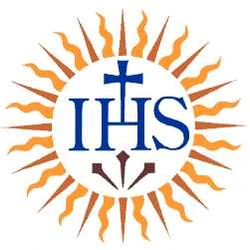The Society of Jesus (Societas Iesu (S.I. or S.J.) in Latin) is a Christian religious order of the Roman Catholic Church in direct service to the Pope. Its members, known as Jesuits since the Protestant Reformation, have been called "Footsoldiers of the Pope" in part because the Society's founder, Saint Ignatius of Loyola, was a soldier before he began to follow God as a monk and eventually a priest. Today, Jesuits number almost 20,000 and comprise the largest single religious order in the Catholic Church. Jesuit priests and brothers are engaged in ministries in 112 nations on six continents. Their work is focused on education and intellectual contributions, primarily at colleges and universities, as well as missionary work and ministry in human rights and social justice.
The Society of Jesus is consecrated under the patronage of Madonna Della Strada, a title of the Blessed Virgin Mary, and is led by a Superior General, presently Father General Adolfo Nicolás SJ, who was elected January 19th, 2008, to replace Fr. Peter Hans Kolvenbach. The General Curia of the Society is headquartered in Rome. Its historic complex of buildings includes the Church of the Gesu, the Jesuit Mother Church.
Foundation[]
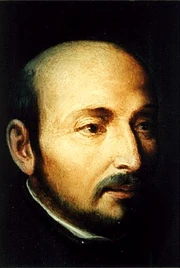
Saint Ignatius of Loyola, founder of the Society of Jesus
On August 15, 1534, Ignatius (born Iñigo López de Loyola) and six other students (Francis Xavier, Alfonso Salmeron, James Lainez, and Nicholas Bobadilla, fellow Spaniards, Peter Faber from France and Simon Rodrigues, a Portuguese) met in Montmartre outside Paris, probably near the modern Chapel of St Denys, Rue Antoinette, and binding themselves by a vow of poverty and chastity, founded the Society of Jesus – to "enter upon hospital and missionary work in Jerusalem, or to go without questioning wherever the pope might direct".[1]
In 1537 they travelled to Italy to seek papal approval for their order. Pope Paul III gave them a commendation, and permitted them to be ordained priests. They were ordained at Venice by the bishop of Arbe (June 24). They devoted themselves to preaching and charitable work in Italy, as the renewed war between the Holy Roman Emperor Charles V, Venice, the pope and the Ottoman Empire rendered any journey to Jerusalem inadvisable.
With Faber and Lainez, Ignatius made his way to Rome in October 1538, to have the pope approve the constitution of the new order. A congregation of cardinals reported favorably upon the constitution presented, and Paul III confirmed the order through the bull Regimini militantis (September 27, 1540), but limited the number of its members to sixty. This limitation was removed through the bull Injunctum nobis (March 14, 1543). Ignatius was chosen as the first superior-general. He sent his companions as missionaries around Europe to create schools, colleges, and seminaries.[2]
When developed, Jesuits concentrated on three activities. First, they founded superb schools throughout Europe. Jesuit teachers were rigorously trained in both classical studies and theology. The Jesuits' second mission was to convert non-Christians to Catholicism, so they developed and sent out missionaries. Their third goal was to stop Protestantism from spreading. The zeal of the Jesuits overcame the drift toward Protestantism in Poland and southern Germany.
Ignatius wrote the Jesuit Constitutions, adopted in 1554, which created a monarchical organization and stressed absolute self-abnegation and obedience to Pope and superiors (perinde ac cadaver, "[well-disciplined] like a corpse" as Ignatius put it). His main principle became the unofficial Jesuit motto: Ad Maiorem Dei Gloriam ("for the greater glory of God"). This phrase is designed to reflect the idea that any work that is not evil can be meritorious for the spiritual life if it is performed with this intention, even things considered normally indifferent.[2]
The Society of Jesus is classified among institutes as a mendicant order of clerks regular, that is, a body of priests organized for apostolic work, following a religious rule, and relying on alms, or donations, for support.
The name "Jesuit"[]
The term "Jesuit" (of fifteenth-century origin, meaning one who used too frequently or appropriated the name of Jesus), was first applied to the Society in reproach (1544-52), and was never employed by its founder, though members and friends of the Society in time appropriated the name in its positive meaning.
Early works[]
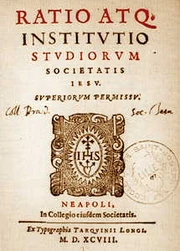
Ratio Studiorum, 1598
The Jesuits were founded just before the Counter-Reformation, a movement whose purpose was to reform the Roman Catholic Church from within and to counter the Protestant Reformers, whose teachings were spreading throughout Catholic Europe. As part of their service to the Roman Church, the Jesuits encouraged people to continue their obedience both to scripture and also Roman Catholic doctrine. Ignatius himself used hyperbole when he wrote the following sentence:
- "I will believe that the white that I see is black if the hierarchical Church so defines it."[3]
But his hyperbole relativizes propositional claims defined by the hierarchical Church. For him, the important things in life are not propositional definitions, but the spiritual movements within oneself.
Ignatius and the early Jesuits did recognize, though, that the hierarchical Church was in dire need of reform, and some of their greatest struggles were against the corruption, venality, and spiritual lassitude within the Roman Catholic Church. As a result, in spite of their loyalty, Ignatius and his successors often tangled with the pope and the Roman Curia. Over the 450 years since its founding, the Society has both been called the papal "elite troops" and been forced into suppression.
St. Ignatius and the Jesuits who followed him believed that the reform of the Church had to begin with the conversion of an individual’s heart. One of the main tools the Jesuits have used to bring about this conversion has been the Ignatian retreat, called the Spiritual Exercises. During a four-week period of silence, individuals undergo a series of directed meditations on the life of Christ. During this period, they meet regularly with a spiritual director, who helps them understand whatever call or message God has offered in their meditations. The retreat follows a Purgative-Illuminative-Unitive pattern in the tradition of the mysticism of John Cassian and the Desert Fathers. Ignatius' innovation was to make this style of contemplative mysticism available to all people in active life, and to use it as a means of rebuilding the spiritual life of the Church.
The Jesuits’ contributions to the late Renaissance were significant in their roles both as a missionary order and as the first religious order to operate colleges and universities as a principal and distinct ministry. By the time of Ignatius' death in 1556, the Jesuits were already operating a network of 74 colleges on three continents. A precursor to liberal education, the Jesuit plan of studies incorporated the Classical teachings of Renaissance humanism into the Scholastic structure of Catholic thought. In addition to teaching faith, the Ratio Studiorum emphasized the study of Latin, Greek, classical literature, poetry, and philosophy as well as non-European languages, sciences and the arts. Furthermore, Jesuit schools encouraged the study of vernacular literature and rhetoric, and thereby became important centers for the training of lawyers and public officials. The Jesuit schools played an important part in winning back to Catholicism a number of European countries which had for a time been predominantly Protestant, notably Poland. Today, Jesuit colleges and universities are located in over one hundred nations around the world.
Following the Roman Catholic tradition that God can be encountered through created things and especially art, they encouraged the use of ceremony and decoration in Catholic ritual and devotion. Perhaps as a result of this appreciation for art, coupled with their spiritual practice of "finding God in all things", many early Jesuits distinguished themselves in the visual and performing arts as well as in music.
The Jesuits were able to obtain significant influence in the Early Modern Period because Jesuit priests often acted as confessors to the Kings of the time. They were an important force in the Counter-Reformation and in the Catholic missions, in part because their relatively loose structure (without the requirements of living in community, saying the divine office together, etc.) allowed them to be flexible to meet the needs of the people at the time.
Expansion[]
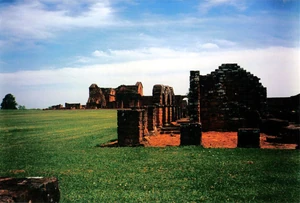
Ruins of La Santisima Trinidad de Parana in Paraguay, one of the many Jesuit missions established in South America during the 17th and 18th centuries
Early missions in Japan resulted in the government granting the Jesuits the feudal fiefdom of Nagasaki in 1580. This was removed in 1587, however, due to fears over their growing influence.
Francis Xavier arrived in Goa, in Western India in 1541 to consider evangelical service in the Indies. He died after a decade of evangelism in Southern India. Under Portuguese royal patronage, the order thrived in Goa and until 1759 successfully expanded its activities to education and healthcare. On 17 December 1760, Marquis of Pombal, Secretary of State in Portugal expelled the Jesuits from India.
Two Jesuit missionaries, Gruber and D'Orville, reached Lhasa in Tibet in 1661.
Jesuit missions in Latin America were very controversial in Europe, especially in Spain and Portugal, where they were seen as interfering with the proper colonial enterprises of the royal governments. The Jesuits were often the only force standing between the Indians and slavery. Together throughout South America but especially in present-day Brazil and Paraguay they formed Christian-Indian city-states, called "reductions" (Spanish Reducciones). These were societies set up according to an idealized theocratic model. It is partly because the Jesuits protected the Indians whom certain Spanish and Portuguese colonizers wanted to enslave that the Society of Jesus was suppressed.
Jesuit priests such as Manoel da Nóbrega and José de Anchieta founded several towns in Brazil in the 16th century, including São Paulo and Rio de Janeiro, and were very influential in the pacification, religious conversion and education of Indian nations
Jesuit mission in China brought about the Chinese Rites controversy in the early 18th century.
Jesuit scholars working in these foreign missions to the "heathens" were very important in understanding their unknown languages and strived for producing Latinicized grammars and dictionaries, the first organized efforts at linguistics. This was done, for instance, for Japanese (see Nippo jisho also known as Vocabvlario da Lingoa de Iapam, a Japanese-Portuguese dictionary written 1603) and Tupi-Guarani (a language group of South American aborigines).
Suppression and restoration[]
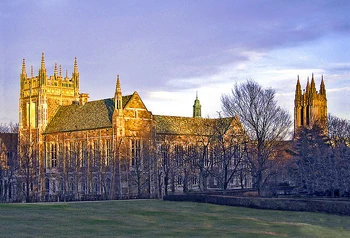
Boston College was among the first universities to open after the Restoration of the Jesuits in North America. Today it is the home to the world's largest Jesuit community
- Main article: Suppression of the Jesuits
The Suppression of the Jesuits in Portugal, France, the Two Sicilies, Parma and the Spanish Empire by 1767 was troubling to the Society's defender, Pope Clement XIII. Following a decree signed by Pope Clement XIV in July 1773, the Jesuits were suppressed in all countries except Russia, where Catherine the Great had forbidden the papal decree to be promulgated. Because millions of Catholics (including many Jesuits) lived in the Polish western provinces of the Russian Empire, the Society was able to maintain its legal existence and carry on its work all through the period of suppression.
The period following the Restoration of the Jesuits in 1814 was marked by tremendous growth, as evidenced by the large number of Jesuit colleges and universities established in the 19th century. In the United States, 22 of the Society's 28 universities were founded or taken over by the Jesuits during this time. Some claim that the experience of suppression served to heighten orthodoxy among the Jesuits upon restoration. While this claim is debatable, Jesuits were generally supportive of Papal authority within the Church, and some members were associated with the Ultramontanist movement and the declaration of Papal Infallibility in 1870.
The 20th century witnessed both aspects of growth and decline. Following a trend within the Catholic priesthood at large, Jesuit numbers peaked in the 1950s and have declined steadily since. Meanwhile the number of Jesuit institutions has grown considerably, due in large part to a later 20th century focus on establishing of Jesuit secondary schools in inner-city areas. Among the notable Jesuits of the 20th century, John Courtney Murray, SJ, was called one of the "architects of the Second Vatican Council" and drafted what eventually became the council's endorsement of religious freedom, Dignitatis Humanae Personae.
Jesuit formation[]
The training of Jesuits seeks to prepare men spiritually, academically and practically for the ministries they will be called to offer the Church and world. St. Ignatius was strongly influenced by the Renaissance and wanted Jesuits to be able to offer whatever ministries were most needed at any given moment, and especially, to be ready to respond to missions (assignments) from the Pope. Formation for Priesthood normally takes between 10 and 12 years depending on the man's background and previous education.
- Candidacy is an informal precursor to becoming a Jesuit, wherein a man interested in joining the Jesuits explores his calling with a spiritual director. The candidate attends vocation events, including retreats and discussions with other candidates and Jesuits. Candidacy can last any length of time, with the norm being about a year. During this time, the candidate may or may not live in a Jesuit community.
- Novitiate is the first stage of formation. The Novice begins to live the three vows of poverty, chastity, obedience (though he has not yet vowed himself publicly), completes the Spiritual Exercises of St. Ignatius, learns about the history and practice of the order and enters into a series of “experiments.” These experiments are usually short ministerial assignments where the novice tests his aptitude for various ministries, such as, teaching, working with the marginalized or giving retreats. The novitiate lasts 2 years.
At this point, the novice pronounces his First Vows (perpetual Simple vows of poverty, chastity and obedience) and becomes either a Scholastic (entering onto the path of priesthood) or a Jesuit brother. The scholastics and Brothers of the Society of Jesus have different courses of study, although they often overlap.
For scholastics, the usual course of studies is as follows:
- First Studies is the period when the scholastic begins his academic training. Depending on his prior education it will last 2-4 years, guaranteeing a grounding in Philosophy and the attainment of at least a first university level degree. It may also introduce the study of theology or some other specialized area.
- Regency is the next stage, wherein the scholastic lives and works in a typical Jesuit community (as opposed to the “formation communities” he has lived in so far). He is engaged full-time in ministry (an Apostolate), which is traditionally teaching in a secondary school, but it may be any ministry Jesuits are engaged in. Regency lasts for 2-3 years.
- Theology is the stage immediately preceding ordination. By universal canon law, every candidate for priestly ordination must complete four years of theology studies, though part of this requirement may have been met in first studies. This will include the attainment of a first degree in theology, and usually a second (masters level) degree in a specialized area related to theology.
- Ordination follows, and the new Priest may receive a ministerial assignment or be sent back for further studies in any academic field.
- Tertianship follows within a few years of ordination. After his first experience of ministry as a priest, the Jesuit completes the final stage of formal formation by revisiting the essentials of Jesuit life which he learned as a novice: once again, he studies the history and Constitutions of the Jesuits, he makes the Spiritual Exercises and participates in experiments.
- Final Vows follow upon tertianship, wherein the Jesuit pronounces perpetual solemn vows of poverty, chastity, obedience, and the Fourth vow, unique to Jesuits, of special obedience to the pope in matters regarding mission.
The formation of Jesuit brothers has a much less structured form. Prior to the Second Vatican Council, Jesuit brothers worked almost exclusively within Jesuit communities as cooks, tailors, farmers, secretaries, librarians and maintenance support. Following the Second Vatican Council, which recognized the mission of all the Christian faithful, not just those who are ordained, to share in the ministries of the Church, Jesuit brothers began to engage in ministries outside of their communities. Today, the formation of a Jesuit brother may take many forms, depending on his aptitude for ministry. He may pursue a highly academic formation which mirrors that of the scholastics, or he may pursue more practical training in areas such as pastoral counseling or spiritual direction, or he may continue in the traditional “supporting” roles in which so many Jesuit brothers have attained notable levels of holiness.
Regardless of the practical details, Jesuit formation is meant to form men who are open and ready to serve whatever is the Church’s current need. Today, all Jesuits are expected to learn English, and those who speak English as a first language, are expected to learn Spanish.
Jesuits today[]
The Jesuits today form the largest religious order of priests in the Catholic Church, with over 20,000 members serving in 112 nations on six continents. The current Superior General of the Jesuits is Peter Hans Kolvenbach. The Society is characterized by its ministries in the fields of missionary work, human rights, social justice and, most notably, higher education. It operates colleges and universities in various countries around the world and is particularly active in the Philippines and India. In the United States alone, it maintains over 50 colleges, universities and high schools. A typical conception of the mission of a Jesuit school will often contain such concepts as proposing Christ as the model of human life, the pursuit of excellence in teaching and learning and life-long spiritual and intellectual growth.[1] In Latin America, Jesuits have had significant influence in the development of liberation theology, a movement which has been highly controversial in the Catholic theological community, condemned by Pope John Paul II on several fundamental aspects.
Under Superior General Pedro Arrupe, social justice and the preferential option for the poor emerged as dominant themes of the work of the Jesuits. Nearly a decade after the assassination of Bishop Oscar Romero, on November 16, 1989, six Jesuit priests – Ignacio Ellacuria, Segundo Montes, Ignacio Martin-Baro, Joaquin Lopez y Lopez, Juan Ramon Moreno, and Amado Lopez – their housekeeper, Elba Ramos, and her daughter, Celia Marisela Ramos, were murdered by the Salvadoran military on the campus of the University of Central America in San Salvador, El Salvador. Due to their unwavering defense of the poor, they had been labeled as subversives by the Salvadorian government. The assassinations galvanized the Society's peace and justice movements, including annual protests at the Western Hemisphere Institute for Security Cooperation at Fort Benning, Georgia, where the assassins were trained under US government sponsorship.
In 2002, Boston College president William P. Leahy, SJ, initiated the Church in the 21st Century program as a means of moving the Church "from crisis to renewal." The initiative has provided the Society with a platform for examining issues brought about by the worldwide Roman Catholic sex abuse cases, including the priesthood, celibacy, sexuality, women's roles, and the role of the laity.
In April 2005, Thomas J. Reese, SJ, editor of the American Jesuit weekly magazine America, resigned at the request of the Society. The move was widely published in the media as the result of pressure from the Vatican, following years of criticism by the Congregation for the Doctrine of the Faith on articles touching subjects such as HIV/AIDS, religious pluralism, homosexuality and the right of life for the unborn. Reese is currently on a year-long sabbatical at Santa Clara University.
On February 2, 2006, Fr. Peter Hans Kolvenbach, informed members of the Society of Jesus, that with the consent of Pope Benedict XVI, he intends to step down as Superior General in 2008, the year he will turn 80. The 35th General Congregation of the Society of Jesus that will elect a new superior general, and decide other important policy for the Jesuit order in the years to come, will convene on 5 January 2008, in Rome.
While the Jesuit superior general is elected for life, the order's constitutions allow him to step down.
Controversies[]
The Jesuits have frequently been described by Catholic and Protestant enemies as engaged in various conspiracies. They have also been accused of using casuistry to obtain justifications for the unjustifiable. In several languages, "Jesuit" or "Jesuitical" therefore acquired a secondary meaning of "devious." The Jesuits have also been targeted by many anti-Catholics like Jack Chick, Avro Manhattan, and Alberto Rivera. Among other things they point to the text of an extreme oath allegedly taken by advanced members of the order, which can be construed to justify any action including infiltration of other faiths as legitimate in the name of the "greater good." The Jesuits have been accused of murdering Popes and presidents, causing wars, and toppling governments. There is also a claim common among many anti-Catholics that the Jesuit Superior General rules the Vatican behind the scenes. Within the Catholic Church, some Jesuits are criticized by some parties for being overly liberal and deviating substantially from official Church teaching and papal directives, especially on such issues as abortion, priestly celibacy, homosexuality, and liberation theology. [2] [3] [4] [5] [6] [7] [8] Pope Benedict XVI, like his predecessor John Paul II, has been particularly critical of the order. [9] Indeed, it is not unusual, especially in more conservative Catholic outlets, to hear calls for the outright abolishment of the Jesuit order. Thus, some may argue that the future influence of the Jesuits in the Catholic community, and perhaps their very existence, remains uncertain, while others may note that the Jesuit Order is well established in the Church and the communities where they intervene.
Famous Jesuits[]
Among many distinguished early Jesuits was St. Francis Xavier, a missionary to Asia who converted more people to Catholicism than anyone in Catholic history before him.
Other famous Jesuits include:
- Abbé Augustin Barruél, French writer
- St. Alberto Hurtado, Chilean social reformer
- Claude-Jean Allouez, French Jesuit, missionary to Wisconsin
- Alessandro Valignano, Italian Jesuit, missionary to Japan and East Asia
- Alexandre de Rhodes, missionary to Vietnam
- Alfred Delp, German Jesuit hanged for his opposition to Hitler
- St. Aloysius Gonzaga, Italian Jesuit, Patron Saint to young students
- Amando López, one of the 6 Jesuit martyrs in UCA El Salvador
- St. Andrew Bobola, Polish Missionary, killed by the Cossacks
- Anthony de Mello, controversial Indian Spiritual Writer
- Antonio Vieira, (1608-1697), missionary and diplomat.
- Athanasius Kircher, 17 Century prolific German Scientist, discoverer of microbes
- Avery Dulles, American theologian and cardinal
- Bernard Lonergan, Canadian philosopher and theologian
- Catalino Arevalo, hailed by the late Jaime Cardinal Sin as the "dean of Filipino theologians"
- Daniel Berrigan, American Political Activist
- Edmund A. Walsh, founder of the School of Foreign Service at Georgetown University
- St. Edmund Campion, English martyr
- Eduardo Dougherty, American-Brazilian educator, communicator and leader of the Catholic Charismatic Renewal in Brazil
- Eusebio Francisco Kino, Prolific Missionary and Cartographer of Mexico
- Leonard Feeney, Controversial Ultra-Conservative American Jesuit
- Ferdinand Verbiest, Belgian missionary to China
- Francois d'Aguillon, Belgian Mathematician and Physicist
- Frans Jozef van Beeck, theologian
- Franz Jetzinger, theology professor, Austrian political figure, and principal biographer of Adolf Hitler's early years
- Frederick Copleston, English writer of a definitive History of Western Philosophy (vol 1-12)
- Gerard Manley Hopkins, renowned English poet
- Gian Paolo Oliva, General of the Order, 1664–1681
- Giovanni Botero, Italian thinker, discharged from the Society in 1579
- Giulio Alenio, Italian Missionary to China, "Confucius of the West"
- Giuseppe Castiglione, artist to Chinese Emperor
- Georg Joseph Kamel Botanist assigned to the Philippines and whose work is well known in Pharmacy. The Camellia flower was named after him.
- St. Henry Garnett, First English Provincial, executed after being falsely implicated in the 'Gunpowder Plot'
- Horacio De La Costa Philippine historian and the first Filipino Jesuit provincial superior in the Philippines
- Ignacije Szentmartony, Croatian mathematician and Astronomer
- Ignacio Ellacuría, Rector of University of Central America, El Salvador - shot dead in 1989
- Ignacio Martín-Baró
- Jacques Courtois, French Painter in 17th Century
- Jacques Dupuis, Belgian theologian and expert on Inter-Religious Dialogue and Theology of Religions
- Jacques Marquette
- Jaime Bulatao, professor of psychology at Ateneo de Manila University in the Philippines, considered as the father of "Filipino psychology"
- Jakob Balde, German latinist, court chaplain to Maximillian I
- James Reuter, considered as the father of Catholic mass communications in the Philippines
- James Walsh, Georgetown University professor of Theology, musician, and philosopher
- Jean Joseph Marie Amiot, French Missionary to China
- Jeremiah Delgado
- Joaquín López y López
- Johann Adam Schall von Bell, missionary to China
- St. John Berchmans, Jesuit Seminarian from Belgium
- John Carroll (priest), first bishop of the United States and founder of Georgetown University
- John Courtney Murray, drafter of the Second Vatican Council
- John Dear, American Jesuit Peace Activist and Spiritual Author
- John II Casimir Vasa, king of the Polish-Lithuanian Commonwealth
- John Gerard, English Jesuit - one of the few men to escape from the Tower of London
- John O'Sullivan, Irish ascetic
- José de Acosta, Spanish Historian,Natural and Moral History of the Indies
- José de Anchieta, founder of São Paulo, Brazil
- St. José María Rubio, Spanish Jesuit, canonised by the late Pope John Paul II in 2003
- José María Vélaz, founder of Fe y Alegria.
- Juan Andres, Prolific 18th Century Spanish Writer
- Juan Ramón Moreno
- Karl Rahner, one of the most significant 20th century theologians
- Leonardus Lessius, Flemish moral theologian and writer on economics
- Louis Bourdaloue, French Preacher and Orator
- Louis Maimbourg
- Luis Frois, Portuguese Missionary to Japan, wrote History of Japan
- Manoel da Nóbrega, Portuguese Jesuit, founder of Rio De Janeiro, Brazil
- Martin Royackers, Canadian priest martyred in Jamaica in 2001
- Matteo Ricci, famed missionary to China
- Michel de Certeau, French Cultural Theorist
- Sebastian Kappen, Indian Theologian
- Oswald von Nell-Breuning
- Pedro Arrupe, Former Superior General of the Society
- St. Peter Claver, Saint to the Slave Ships in South America
- Peter Faber, Highly Esteemed companion of Ignatius, Apostle of Germany
- St. Petrus Canisius, Doctor of the Church
- Petrus Josephus Zoetmulder, an expert in the Old Javanese language and literature
- Pierre Teilhard de Chardin, French paleontologist and spiritual writer
- St. Robert Bellarmine, a Doctor of the Catholic Church
- Robert Drinan, only Catholic priest ever to serve in the US Congress [4]
- Roberto de Nobili, missionary to India
- Romeo Intengan, Philippine Jesuit, former Provincial, and surgeon by training, jailed during the dictatorship of Ferdinand Marcos for his views against the dictatorship
- Roque Ferriols, Filipino philosopher
- Saint Roque González de Santa Cruz, Paraguayan missionary, martyr
- Ruđer Josip Bošković (aka Roger Boscovich), Croatian atomic physicist, forerunner of Faraday
- Segundo Montes
- Thomas Ewing Sherman, son of a US Civil War Union Army Major General William T. Sherman
- Walter J. Ong, American cultural historian and spiritual writer
- Xabier Arzalluz, Spanish Basque leader, later left the Society
- Walter Kerber, German Professor of Ethics
See also: the Canadian Martyrs and Jesuit China missions
- ↑ McCoog, Thomas M. (1996) "The Society of Jesus in Ireland, Scotland, and England 1541-1588" Brill Academic Publishers. 318 pp. ISBN 9004104828.
- ↑ 2.0 2.1 Hopfl, Harro (2004) "Jesuit Political Thought : The Society of Jesus and the State, C.1540-1630" Cambridge University Press. 426 pp. ISBN 0521837790.
- ↑ Cheyne, Colin (2001) "Knowledge, Cause, and Abstract Objects: Causal Objections to Platonism" Springer 252 pp. ISBN 1402000510.
- ↑ Note: Father Gabriel Richard briefly was in the US Congress in the 1820s, but as a territorial representative. Under guidelines released by Pope John Paul II, Catholic clergy are expected not to serve in positions of civil authority.
Jesuit institutions[]
- Main article: List of Jesuit institutions
Jesuits have founded and/or managed a number of institutions, notably universities, which have produced many well-known alumni.
The most prominent of these universities are in the United States where they are organized as the Association of Jesuit Colleges and Universities. In Latin America they are organized in the Asociación de Universidades Confiadas a la Compañía de Jesús en América Latina (Association of Universities Entrusted to the Jesuits in Latin America).
In the Philippines, the Jesuit universities are all independent, although they maintain institutional ties. The Ateneo de Manila University, Ateneo de Naga University, Xavier University-Ateneo de Cagayan, Ateneo de Zamboanga University and Ateneo de Davao University are all loosely federated. An affiliated grouping, Mindanao Consortium of Ateneo Universities, groups all of the Jesuit universities located in Mindanao island with the purpose of promoting Muslim-Christian unity and dialogue as well as to exchange knowledge and expertise in various academic fields.
Jesuit buildings[]
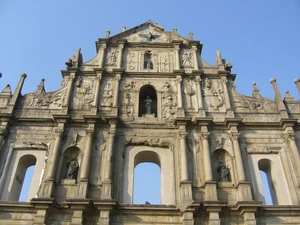
Ruins of St Paul's Cathedral, Macau, one of many cathedrals built by the Jesuits in Asia during the 16th and 17th centuries
Many buildings and ruins give witness to the order's construction activity world-wide. Among these are:
- Ruins of Saint Paul's Cathedral in Macau
- Ruins of San Ignacio Church in the Philippines
- Basilica of Bom Jesus near Panaji, Goa in India
- Church of the Gesu in Rome, Italy
- Ateneo de Manila University Church of the Gesu in the Philippines
- La Santisima Trinidad de Parana in Paraguay
See also[]
- Superior General of the Society of Jesus
- Acta Sanctorum
- Association of Jesuit Colleges and Universities
- Brebeuf College School
- Bollandist
- Catholicism in China
- Catholicism in Japan
- Jesuit Ivy
- Jesuit pre-modern China missions
- Laying on of hands
- Madonna Della Strada
- Misiones Province, Argentina
- Ratio Studiorum
- St. Paul's School,(Belgaum)
- The Mission — Starring Robert De Niro and Jeremy Irons and directed by Roland Joffe, this 1986 film is about Spanish Jesuit missionary work among the Guarani of South America, who are threatened by Portuguese colonial slavers (based on the real-life Jesuit Reductions).
External links[]
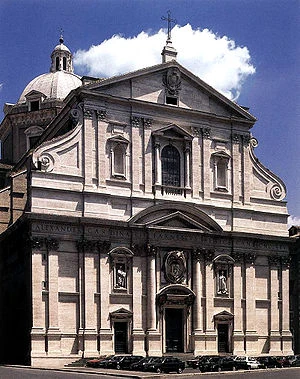
Church of the Gesu, motherchurch of the Society of Jesus in Rome
Sites[]
- J.H. Pollen, "The Jesuits (Society of Jesus)" in the Catholic Encyclopedia (1912)
- The Jesuit Portal - Jesuit Worldwide Homepage
- Jesuit universities in the Philippines
- Jesuits in Canada
- Jesuits in the Philippines
- United States Jesuit Conference
- Jesuit Volunteer Corps
- Association of Jesuit Colleges and Universities
- Jesuits in the United Kingdom
- Jesuits in Indonesia
- Jesuits in Australia
- Jesuits in South Africa
- Sacred Space: famous Jesuit prayer site, in 18 different languages, maintained by Jesuits of the Irish Province
- Pray-as-you-go: latest initiative by the British Jesuits, providing daily prayer in MP3 format for use "on the go"
- Global Catholic Statistics: 1905 and Today by Albert J. Fritsch, SJ, PhD
Media[]
- Documentary by the Society of Jesus Province of Chicago (Windows Media Player)
- Contemporary Jesuits speak about their vocations, the vows, and the mission of the Society of Jesus (Real Player)
| This page uses Creative Commons Licensed content from Wikipedia (view authors). |
